2009 Annual Science Report
 NASA Goddard Space Flight Center
Reporting | JUL 2008 – AUG 2009
NASA Goddard Space Flight Center
Reporting | JUL 2008 – AUG 2009
Origin and Evolution of Organics in Planetary Systems
Project Summary
The central goal of the Blake group effort in the NASA GSFC Astrobiology node (Origin and Evolution of Organics in Planetary Systems (Mike Mumma, P.I.) is to determine whether complex organics such as those seen in meteorites are detectable in the circumstellar accretion disks that encircle young stars and in the comae of comets. Our program has both observational and laboratory components. We use state-of-the-art telescopes from microwave to optical frequencies, and we have developed novel high frequency and temporal resolution instruments that seek to utilize the unique properties of the terahertz (THz) modes of complex organics. The astronomical searches for such modes will begin with Herschel PACS and HIFI observations in early 2010, and will continue with SOFIA and ALMA studies as these observatories become operational in CY2011 and CY2012. The overall suite of laboratory and observational research promises to revolution our understanding of prebiotic chemistry in both our own and other solar systems.
Project Progress
As part of the overall Astrobiology Node at the NASA Goddard Space Flight Center, whose goal is an understanding of the Origin and Evolution of Organics in Planetary Systems (Mike Mumma, P.I.), Co-Investigator Blake is directing both laboratory and astronomical spectroscopy programs. The goal of these observations is to determine whether complex organics are detectable in the circumstellar accretion disks that encircle young stars and in the comae of comets. Targets of study are being selected in collaboration with Node scientists investigating the organic speciation in carbonaceous chondrites and comets.
The experimental work is being carried out in Prof. Blake’s laboratories in the Caltech Beckman Institute, and the observational research in FY10 and beyond will continue to lean heavily on both spacecraft and on the extensive suite of Caltech telescopes, especially the Combined Array for Research in Millimeter Astronomy (or CARMA, the merging of the Caltech Owens Valley Millimeter Array and the Berkeley-Illinois-Maryland Array at Hat Creek, CA), the Caltech Submillimeter Observatory (CSO), and the Keck telescope(s). In the laboratory, the Blake group operates both a Fourier Transform MicroWave (FTMW) spectrometer, a THz laser difference frequency photomixer spectrometer, and has just completed the construction of two new THz time domain spectrometers (THz TDS) with funds from the NSF Chemistry Research Infrastructure and Facilities (CRIF) programs. This results in continuous coverage from the microwave to the optical with exceptional sensitivity.
The successes achieved by our work supported by the Astrobiology program since 2003, has lead to major new funding for laboratory equipment that in turn is enabling major advances in the spectroscopy of complex organic compounds in space. Our Astrobiology funds have now been highly leveraged by additional Federal support, and the synergism among these programs is responsible for many of the coupled advances described below.
Astronomical Spectroscopy
For observational work, the CSO has receivers that operate through all of the atmospheric windows between 180-980 GHz, and CARMA offers superb imaging performance in the 100/230 GHz windows now that the telescopes are fully operational at the new site in the Inyo Mountains. Our infrared program combines spectral surveys of a selection of >100 young stellar objects (YSOs) with the IRS instrument aboard the (now warm) Spitzer Space Telescope that is being followed up with detailed Keck NIRSPEC/VLT CRIRES high spectral resolution observations of key YSOs and comets. Starting later this fall as part of the Herschel Science Demonstration Program, we plan to utilize the THz heterodyne receivers in HIFI (constructed by) Caltech/JPL as part of our work on the U.S. Guaranteed Time Team.
Two specific avenues are being pursued. The infrared spectra provide great insight into small-to-moderate sized molecules present in both the gas and icy grains surrounding protostars and in comets, as described below. We use these observations to establish the initial conditions for high temperature chemistry close to the star, and then couple these results with models and meteorite/comet chemistry to determine which more complex organics should be the focus of laboratory study. The laboratory results then provide the necessary data for observational searches at microwave through THz frequencies using a variety of telescopes. Our latest results and some plans for the future are outlined next.
In the area of cometary studies, we are heavily dependent upon the available apparitions. At present we are primarily working on finalizing our collaborative observations with the Mumma group that have utilized both Keck NIRSPEC and with the newly commissioned Combined Array for Research in Millimeter Astronomy, or CARMA. Data reduction is now complete for the infrared echelle work, and an initial paper on Comet C/2007 W1/Boattini is in preparation by the Mumma group. This apparition offered one of the first realistic chances to attempt detections of the infrared emission from HDO. Over the nights of 9-10 July 2008 we observed Boattini in three NIRSPEC echelle settings for a total of ~2 hours clock time. With overhead, this resulted in somewhat less than an hour of actual integration time – insufficient to detect HDO, but a wealth of molecules are seen. This comet shows highly unusual organic grain signatures and very large ethane/water ratios. The Mumma group reduced the data in record time while we were at the telescope to optimize the second night’s observing.
For CARMA observations, unanticipated data acquisition issues with the first generation correlator have made the reduction of the (u,v)-plane visibility data on such rapidly moving targets a challenge, but with the second generation correlator now installed and appropriate new modules for the MIRIAD software suite used by the CARMA consortium, molecular emission has successfully been detected from a comet in just the past few weeks during the 2009 Summer School. The greatly improved (u,v)-plane coverage should enable much more robust detections of features such as cometary jets (see Blake et al. 1999 for such mm-wave jets in Comet Hale-Bopp), while the improved sensitivity will enable a new generation of cometary research such as the measurement of the D/H ratio in Jupiter-family comets once the next generation 230 GHz receivers based on mixers developed for the Atacama Large Millimeter Array (ALMA) are installed in calendar year 2010.
Our highest priority with Keck and the VLT has been to expand upon our exciting discovery of gas phase absorption bands from organics in the inner disk of the YSO IRS 46 in the Ophiuchus molecular cloud (Lahuis et al. 2006). This nearly edge on disk shows high temperature absorption bands of the organic molecules HCN and acetylene with the Spitzer IRS. Follow up JCMT and Keck NIRSPEC observations demonstrate that these molecules are present in the inner disk or inner disk wind, and are thus tracing the high temperature organic chemistry long predicted to occur in the regions of the solar nebula wherein the planetesimals that formed the asteroid belt and terrestrial planets originated.
One of the most intriguing questions in the study of planet formation, for terrestrial planets in particular, is how water and organic compounds are transported to their surfaces, and whether or not water is a common ingredient during their early formation and evolution. Observations of water vapor and the simple but rather less abundant precursors to complex organics (HCN, C2H2, CH4) in extrasolar planets, and in proto-planetary disks undergoing planetary formation, would be instrumental in resolving these questions, and so we have been working to improve our data reduction pipeline for the far more numerous inclined disks toward molecular clouds to search for molecular emission, and we have been spectacularly successful. Indeed, our (Salyk et al. 2008) and the Carr & Najita (2008) team’s detection of warm water and organics around young stars (Figs. 1, 2 & 3), which have generated strong public interest, open up a new era in the study of disk physics and chemistry. Interestingly, the HCN and C2H2 abundances appear to be significantly enhanced in the inner disk (Lahuis et al. 2006), and the combined measurements of the water and organic content inside of R≤10 AU should enable several aspects of disk evolution to be addressed, including: * Water in the Inner Disk & the Formation of Icy Bodies. The diffusional transport of volatiles (Stevenson & Lunine 1988) and the differential radial migration of disk solids (Ciesla & Cuzzi 2006) can significantly affect the abundances of condensable species such as water inside the “snow line.” Thus, observations of water vapor can provide direct tests of models of disk evolution and planetesimal growth/migration, and will also bear on theories for the origin of water on Earth and other inner solar system bodies. * Turbulent Mixing. The strong molecular emission that we detect was largely unexpected theoretically, and may suggest that these species are turbulently mixed upward from the disk mid-plane where they are abundant. Can molecular abundances provide a chemical signature of this central process? * Grain Growth & Settling. Disks may also show varying molecular abundances as a consequence of grain growth/settling, and so it is important to examine gas in disks for which varying degrees of grain growth are inferred. * External Irradiation. Young stars are strong X-ray/UV emitters, which can significantly impact disk chemistry and lifetimes. Our detection of strong OH lines (Carr & Najita 2008, Salyk et al. 2008, Mandell et al. 2008) may be particularly interesting in this regard, for OH is stable against Ly α photolysis.
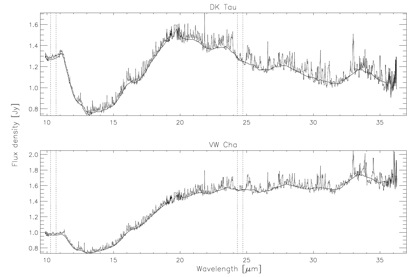
Figure 1. Figure 1.- Overview of the Spitzer GO-5 data for DK Tau/VW Cha, illustrating the substantial line-to-continuum ratios that are seen toward some disks even at R=600. The dark gray line is the spline fit that is used to estimate the continuum level/contribution.
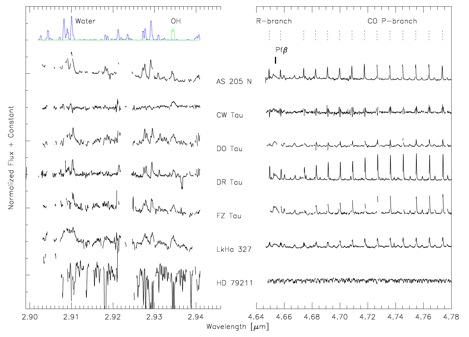
Figure 3. Figure 3.- Ground-based spectra for a sub-sample of the Spitzer GO-5 circumstellar disk sources, and a photospheric standard star, in the L- and M-bands. Spectra have been normalized by the continuum, and multiplied by factors of 7 and 0.5 for the L- and M-bands, respectively. Above the spectra are plotted a water + OH emission model, and labels for the CO P- and R-branches.
To answer these questions the radial and vertical distribution of the water vapor, OH, and simple organics in disks must be determined. Our initial results show that combined L-band observations from the ground and deep Spitzer IRS data provide a highly sensitive means of characterizing the emitting location, physical excitation, and abundances of these species; and so we are undertaking dedicated NIRSPEC/CRIRES surveys that concentrate on a suite of GO-5 Spitzer-IRS sources whose spectra have been acquired in collaboration with Drs. Carr and Najita. Because well-defined predictions of disk chemistry versus perturbations in evolutionary state are not (yet) available, this program deliberately spanned a range in disk settling, accretion rate, and X-ray luminosity. All GO-5 results are now in the Spitzer archive, but our initial Keck runs in July, October, and December 2008 were plagued by poor weather. Thankfully, the Caltech TAC has granted us additional nights in July 2009 in semester 2009A and in October, November, and December in semester 2009B. Results for an initial suite of sources examined with NIRSPEC at L-band are presented in Figure 3. Clearly, water detections in the O-H stretch are possible near 3 μm, but very high dynamic range data are needed as compared with the relatively easy detections of CO M-band emission. We have found that atmospheric model fits to the raw data can improve the dynamic range of the spectra to near shot noise-limited values in our studies of OH emission from the disks around Herbig Ae stars (Mandell et al. 2008), and plan to expand upon these techniques in collaboration with scientists from the Orbiting Carbon Observatory (OCO) mission at JPL.

Figure 5. Figure 5.- An illustration of the 2-D disk radiative transfer model (bottom right) applied to one of the strong ~30 μm water lines seen in the IRS spectra above. Only half of the symmetric disk is shown, and the intense dark (continuum) emission spot at the disk center arises from both the star and hot dust. The lower left panel depicts the predicted Spitzer spectrum at R=600, that at top left the spectrum as it would be observed at a resolution of 100,000 such as is available with VLT-CRIRES or Gemini-TEXES. As shown in the top right panel, the line shapes from nearby lines of different excitation are predicted to be quite distinct at high spectral resolution, and so future ground-based observation in the 10-20 μm range should permit direct access to the snow line in proto-planetary disks. Simulations by K. Pontoppidan.
To access sources in the southern sky, we use CRIRES – a high-resolution near infrared spectrometer recently commissioned for the Very Large Telescope (VLT) of the European Southern Observatory (ESO) in Chile. The instrument offers a combination of AO-assisted spatial resolution (0.1’') and a spectral resolution of R = 100,000 (3 km/s) in the 3-5 µm spectral region. These capabilities are unique, and permit unrivaled spectro-astrometry (SA) observations of the molecular emission from disks. Our SA program with CRIRES has been extremely successful. In the M-band, SA on the VLT yields position-velocity curves for the gas emission with a spatial resolution as high as a few hundred micro-arcseconds, or 0.1 AU in the nearest star-forming regions, at a kinematic resolution of <3 km/s. To put this into perspective, compared to near-infrared interferometers such as Keck and the VLTI, SA achieves roughly 5-10 times higher spatial resolution, 100-1000 times higher spectral resolution and 10-100 times better sensitivity. In practice, the information obtained with these two techniques is complementary. While only interferometers are able to image continuum emission, currently only CRIRES SA is demonstrably able to image gas on 1 AU scales in the disks around Sun-type stars.
Our first paper on this technique is now published in the Astrophysical Journal (Pontoppidan et al. 2008), and concentrates on the CO spectra of transitional disks. A graphical summary of the results is presented in Figure 4. Here, the left panels present the results of fits to the astrometric signatures in the P-branch lines of the CO v =1 → 0 fundamental ro-vibrational band at 4.7 μm for the transitional disks SR 21, HD 135344, and TW Hya (Brown et al. 2007).
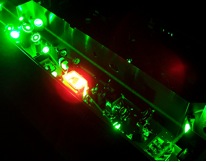
Figure 7 (Right).
From these fits we derive the Position Angle (PA) of the disk major axis on the sky to high precision, and the χ2 surfaces reveal that the disk inclination and stellar mass estimates are strongly correlated, as expected. With quite relaxed constraints on the stellar type from optical spectroscopy, however, the disk inclination can be constrained to within a few degrees. Interestingly, the value derived for TW Hya is rather smaller than that determined from either mm-wave CO emission by the SMA (Qi et al. 2004) or scattered light data from HST. Overall, the trend of inclination versus radius is quite suggestive of a disk warp (Pontoppidan et al. 2008), similar to that seen in β Pic and perhaps caused by as yet unconfirmed protoplanets/companions that are surely present in some such disks (Setiawan et al. 2008).
The combined spectral and imaging data sets provided by NIRSPEC, CRIRES, and the Spitzer IRS demand fast yet accurate radiative transfer tools to extract the disk physical and chemical properties we seek to drive forward our understanding of disk evolution and planet formation. As illustrated in Figure 5, a new excitation and rendering code developed at Caltech can produce synthetic images of disk gas and dust emission that includes the relevant physics without approximation. Interestingly, we find that the emission line profiles from water and OH are quite sensitive to both the physical state (dust settling, inner rim radius, temperature profile) and chemistry (volatile depletion, cosmic ray and X-ray photoionization rates) within the surface layers of the disk. At high dry sites such as those anticipated for the various 20-40m Extremely Large Telescopes (ELTs) under consideration (TMT, GMT, E-ELT), a high dispersion 5-20 μm echelle can measure many water and organic line profiles even from the ground; and the collecting area increase over Keck/VLT is sufficient to bring many dozens of targets within easy reach. We have just finished two large theoretical/modeling papers that describe the new tools and that will appear in Ap. J. (as Pontoppidan et al. 2009 and Meijerink et al. 2009). The major focus of these papers is to showcase the unique capabilities of future ground-based ELTs for directly imaging molecular gas in the planet-forming regions of proto-planetary disks in the near-IR, and also to describe how to extend SA imaging techniques to the recently detected lines of gas-phase water and organics described above into the mid-IR region currently probed only by Spitzer.
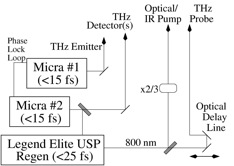
Figure 7 (Left). Figure 7.- (Left) A general schematic of the THz Time Domain Spectroscopy (TDS) systems developed with NSF CRIF:ID support. In year 1 (Sept. 2007-Aug. 2008) the Ti:Sapphire oscillators and regenerative amplifier system (pictured at right) were acquired and installed. In year two (Sept. 2008-Aug. 2009), the first generation THz emitters and detectors have been optimized, and the instrument control and data acquisition/analysis software made (reasonably) user friendly. The output power of Micra #2 is sufficient to drive both the Legend Elite USP regenerative amplifier and the THz detectors (either GaAs-based THz antennae or ZnTe-based electro-optic sensors) at the same time. Thus, the dual oscillator and kHz-rep rate THz TDS systems may be run independently. The second harmonic of the regen can now be used for pump-probe work, and over the next year we will install a third harmonic generator to enable the 800-/400-/267-nm pump and THz probe measurements needed for cosmochemical studies.
Laboratory Spectroscopy: Molecular structure
Our other major group effort involves further laboratory study to enable astronomical searches for complex organics, especially esters, sugars, and polyalcohols, whose spectra we have recently assigned in the laboratory (Widicus et al. 2003, 2004). CSO observations undertaken near perihelion (D. Lis 2004, priv. commun.) have revealed that C/ 2002 T7 (LINEAR) has the highest CH3OH/H2O yet measured for a comet, and comets should thus provide excellent targets for the more complex poly-hydroxylated compounds known to be present in carbonaceous chondrites (Cooper et al. 2001). We are also expanding our search for species such as esters, and have recently used the MOPRA telescope in Australia to tentatively detect methyl acetate – one of the most complex species yet discovered in star- and planet-forming environments (Kelley et al. 2009, in prep; for the lab spectrum of this molecule see Figure 6). The confirmation of this detection with other microwave and sub-millimeter-wave telescopes will be of great interest to Astrobiology.
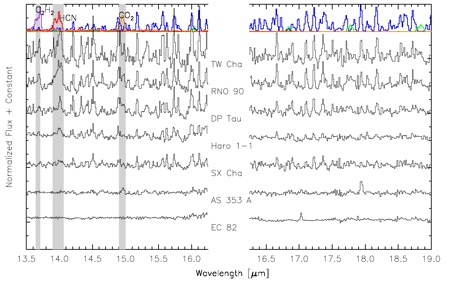
Figure 2. Figure 2.- Continuum-subtracted Spitzer IRS GO-5 spectra illustrating the great diversity of molecular emission that is observed in the sample. When present, the organic molecule emission is very highly correlated with water, the carbon dioxide (15 μm) emission is more variable. All the features in blue atop this figure arise from water vapor, the green lines OH. The line at 17.035 μm is the S(1) transition of H2.
We are also investigating theoretically the role of esterification reactions in grain mantle chemistry with Prof. Eric Herbst at Ohio State and former group member Dr. Susanna Widicus Weaver, who in June 2008 began her appointment as Assistant Professor of Physical Chemistry at Emory University.
The methyl acetate lab spectrum alone shows the tremendous complexity of rotational spectra, and the challenge of molecular line searches in astronomical sources. We believe that a more “statistical” approach to detection of complex molecules is now warranted, and new capabilities recently deployed at the CSO are making such approaches possible by drastically increasing the throughput of searches for complex organics. In particular, new receivers and spectrometers have been installed that increase the bandwidth of data collected in a single local oscillator setting by a factor of eight. These bandwidth improvements along with more sensitive detectors mean that what formerly required many nights of integration can now be achieved in only an hour or two! With this technology we have carried out complete spectral line surveys in the 220-270 GHz region of many hot cores for the first time, and these observations and associated laboratory searches form the thesis research of two students in the Blake group partially supported by the NAI program at GSFC. The results of these theses will set the stage for even more ambitious work to be carried out with the Herschel HIFI and PACS instruments.
Herschel and SOFIA may also offer a novel means of overcoming the spectral line confusion problem that exists at microwave frequencies by examining the THz torsional modes of complex species. Even for moderately complex species such as glycine, the gas phase torsional bands are quite specific, yet little is known about them. In addition, much of the relevant chemistry occurs in the ices that are present on the surfaces of dust grains, yet our understanding of the THz properties of either the ice or the grains themselves is poor. Thanks to support from the NSF Chemistry Research Instrumentation and Facilities (CRIF) program we have installed a matrix isolation system that will use our existing photomixer spectrometer as a `THz sweeper’ to acquire the spectra of molecules in Ne, Ar, and hydrogen matrices. Significant (several percent) absorption features are expected even at 1% target/matrix mixtures only a few microns thick. Nevertheless, the scanning speeds will remain slow and new methods are urgently needed.
Thus, with the CRIF funds we have also built time domain spectrometers in which THz antennae are placed onto optoelectronic substrates with short recombination times, such as low temperature grown (LTG) GaAs (trec ≤250 fs). Illumination of such devices with ultrafast laser optical pulses generates sub-ps THz radiation with bandwidths of ~2-4 THz. Moreover, coherent sub-ps detection of the electric field is possible, which enables both the real and imaginary refractive indices of materials to be measured (Dai et al. 2004). The overall sensitivity can be >105, and a variety of solid state and gas phase THz spectra are now being acquired with the system outlined in Figure 7. These new, state-of-the-art (fs) Ti:Sapphire lasers, now operational in the laboratory, will extend the frequency coverage to at least 10 THz through the use of electro-optic transmitters and receivers based on (110) ZnTe wafers.
Now that our principal technical efforts of installing the state-of-the-art ultrafast lasers that form the heart of the terahertz (THz) time domain spectroscopy (TDS) facility being developed are complete, with the lasers under full computer control and running well, we are turning to an optimization of the sensitivity and temporal resolution of the spectroscopy and pump-probe modes of the instruments. In the original grant, we proposed to build a dual Ti:Sapphire oscillator THz TDS system. With additional funds provided by NASA Laboratory Astrophysics and by Caltech we have added a kHz-repetition rate regenerative amplifier for optical- and near-IR/THz pump-probe capability and integrate it with the original dual oscillator set up. The technologies chosen, and outlined in Figure 7, are the Micra Oscillator/Legend Elite Ultra Short Pulse (USP) regenerative amplifier Ti:Sapphire lasers manufactured by Coherent.
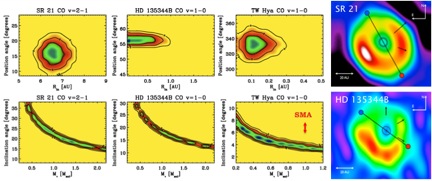
Figure 4. Figure 4.- An overview of the SA fit results from the transitional disks SR 21, HD 135344, and TW Hya (left). The top panels show the chi-squared surfaces for the disk position angles, the lower panels the disk inclination angles and stellar masses (which are highly correlated). The two panels at right summarize the SA results overlaid on recent SMA sub-arcsecond continuum imaging of the SR 21 and HD 135344 disks at 870 μm. The arrows depict the PAs of asymmetries seen in the CO spectro-astrometry, which are well correlated with the cold dust asymmetries seen on larger scales. From Pontoppidan et al. (2008).
Our major astrobiological research interests with THz pulses center on the characterization of large amplitude torsional modes of pre-biotic compounds and on the role that such pulses can play in the study of short timescale charge separation events in protein and DNA assemblages.
The first THz TDS system to be brought on-line was the Micra-based LTG-GaAs photoconductive switch spectrometer. For short temporal scans (<100 ps) we first used a simple optical delay line (ODL), but for these and for high resolution measurements we now use Asynchronous Optical Scanning (AOS) in which the first Micra laser drives the THz emitter and the second Micra laser drives a THz E-O detector. We have just finalized the Micra phase lock electronics and verified their performance, paving the way for arbitrary waveform sampling. Thus, the ODL will no longer be required for spectroscopy or diffraction-limited imaging experiments, and so is being moved to the regenerative amplifier-based THz TDS for full time use in the pump-probe experiments related to solar energy conversion and the photo-remediation of hazardous compounds in the environment
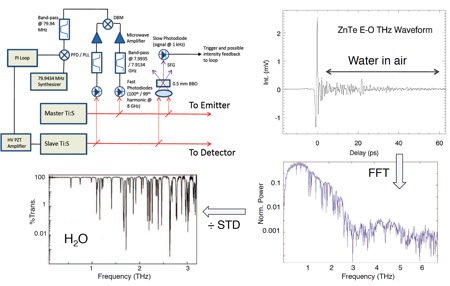
Figure 8. Figure 8.- An overview of the dual oscillator asynchronous optical sampling (AOS) time domain THz spectrometer (top left). The stabilization scheme results in jitter below 100 fs, and absolute frequency calibration to better than a part in 1012. At top right the time domain signature acquired with this instrument in ~20 seconds is displayed. The ``ringing’' after the main pulse is due to atmospheric water vapor, as is shown in the power spectrum produced by an FFT of the time domain data at lower right. When divided by a purged background scan, very high SNR spectra can be acquired in a matter of seconds with a resolution of ~100 MHz and no moving parts (bottom left).
Due to the phase coherent measurement of the THz electric field, both the real and imaginary optical constants of materials may be measured. The real indices are extracted from temporal offsets in the time domain signature, while the imaginary (absorption) coefficients are measured from the power spectrum that is obtained by a Fourier transform of the time domain data. The water spectrum that results from the time domain data in Figure 8 is displayed at bottom left. Our first measurements over ~1 nanosecond windows verified that the free-running time base (and hence the spectroscopic precision) was good to at least a part in a million. We have now implemented phase lock control of the relative cavity lengths, and as a result the spectrometer precision has improved to at least the part per billion range. Over the course of summer 2009 we installed circuits that discipline the time base with access to precision GPS/Boulder atomic clock standards. The resulting spectroscopic precision will ultimately be >> greater than the oscillator cavity repetition rate of 80 MHz, enabling myriad applications in high resolution spectroscopy. Moving forward, our initial science targets are the measurement of the large amplitude torsional bands of pre-biotic compounds, especially amino acids and sugars, first in matrix isolation and then in the gas phase, in support of the Herschel Space Telescope mission.
Launched successfully on 14 May 2009, Herschel stands poised to revolutionize our understanding of the THz sky thanks to its large aperture, sensitive detectors, and operation above the highly absorptive Earth’s atmosphere. Indeed, qualitatively new studies of the refractory dust, ice, and molecular content of the interstellar medium (ISM) will become possible with Herschel; but only if a sufficiently quantitative experimental understanding of these materials is available over the appropriate range of wavelengths and physical conditions. With NASA support we have started a program to measure the THz spectra of refractory dust grain and icy molecular mantle analogs using the compressed-based cryogens-free cryostat installed as part of the THz TDS facility.
The matrix isolation unit has been integrated into the new system, and is undergoing initial tests with organic species such as L,L-Cystine whose temperature-dependent THz optical constants are well known (Yamamoto et al. 2005). We also use a Fourier Transform-InfraRed (FT-IR) spectrometer for the measurement of ice film and substrate thicknesses using well calibrated infrared band strengths of simple molecules (provided by the Herschel Laboratory Astrophysics program). We would like to stress here that the success of these substantial proposals was in large measure driven by our work supported by the Astrobiology program, and as such these funds have now been highly leveraged by additional Federal support.

Figure 6. Figure 6.- A laboratory room temperature spectrum of the double rotor molecule methyl acetate (CH3COOCH3) from ~330 → 360 GHz, illustrating the extremely high line density that results from internal rotation for even moderately small molecules likely to be present in hot cores/inner disks. Searches for methyl acetate are underway at the CSO.
References
Blake, G., Qi, C., Hogerheijde, M., Gurwell, M. & Muhleman, D. 1999, Nature, 398, 213.
Brown, J.M. et al. 2007, Ap. J.(Letters), 664, L107.
Carr, J.S. & Najita, J. 2008, Science, 319, 1504.
Ciesla, F.J., & Cuzzi, J.N. 2006, Icarus, 181, 178.
Cooper, G., Kimmich, N., Belisle, W., Sarinana, J., Brabham, K., & Garrel, L. 2001, Nature, 414, 879
Dai, J., Zhang, J., Zhang, W., & Grischkowsky, D. 2004, J. Opt. Soc. Am. B, 21, 1379.
Gibb, E.L., Van Brunt, K.A., Brittain, S.D., & Retting, T.W. 2007, Ap. J., 660, 1572.
Lahuis, F., Boogert, A..C.A., van Dishoeck, E.F., Pontoppidan, K.M., Blake, G.A., Dullemond, C.P., Evans, N.J., Hogerheijde, M.R., Jorgensen, J.K., Kessler-Silacci, J.E., & Knez, C. 2006, Ap. J.(Letters), 636, L145.
Mandell, A., Mumma, M.J., Blake, G.A., Salyk, C. 2008, Ap. J., 681, L25.
Pontoppidan, K.M., Blake, G.A., van Dishoeck, E.F., Smette, A., Ireland, M.I., & Brown, J. 2008, Ap. J., 684, 1323.
Qi, C., et al. 2004, Ap. J., 616, L7.
Salyk, C., Blake, G.A., Boogert, A.C.A. & Brown, J.M. 2007, Ap. J.(Letters), 655, L105.
Salyk, C., Pontoppidan, K.M., Blake, G.A., Lahuis, F., van Dishoeck, E.F., & Evans, N.J. 2008, Ap. J.(Letters), 676, L49.
Setiawan, J., Henning, T. et al. 2008, Nature, 451, 38.
Stevenson, D.J. & Lunine, J.I. 1988, Icarus, 75, 146.
Widicus, S.L., Drouin, B.J., Dyl, K.A., and Blake, G.A. 2003, J. Mol. Spec., 217, 278.
Widicus, S.L., Braakman, R., Kent, D.R., and Blake, G.A. 2004, J. Mol. Spec., 224, 101.
Yamamoto, K., Kabir, M.H., & Tominaga, K. 2005, J. Opt. Soc. Am. B, 22, 2417.
Publications
-
Hogerheijde, M. R., Qi, C., De Pater, I., Blake, G. A., Friedel, D. N., Forster, J. R., … Wright, M. C. H. (2009). SIMULTANEOUS OBSERVATIONS OF COMET C/2002 T7 (LINEAR) WITH THE BERKELEY-ILLINOIS-MARYLAND ASSOCIATION AND OWENS VALLEY RADIO OBSERVATORY INTERFEROMETERS: HCN AND CH 3 OH. The Astronomical Journal, 137(6), 4837–4845. doi:10.1088/0004-6256/137/6/4837
-
Salyk, C., Blake, G. A., Boogert, A. C. A., & Brown, J. M. (2009). HIGH-RESOLUTION 5 μm SPECTROSCOPY OF TRANSITIONAL DISKS. The Astrophysical Journal, 699(1), 330–347. doi:10.1088/0004-637x/699/1/330
- Mandell, A.M., Mumma, M.J., Blake, G.A., Bonev, B.P., Villanueva, G.L. & Salyk, C. (2008). Discovery of OH in Circumstellar Disks around Young Intermediate-Mass Stars. Ap.J, 681: L25.
- Pontoppidan, K.M., Blake, G.A., Van Dishoeck, E.F., Smette, A., Ireland, M.I. & Borwn, J. (2008). Spectro-astromeetric Imaging f Molecular Gas within Protoplanetary Disk Gaps. Ap.J, 684.
- Qi, C., Wilner, D.J., Blake, G.A. & Hogerheijde, M.R. (2008). Resolving the Chemistry in the Disk of TW Hydrae I. Deuterated Species. Ap.J, 681.
- Salyk, C., Pontoppidan, K.M., Blake, G.A., Lahuis, F., Van Dishoeck, E.F. & Evans, N.J. (2008). H 2 O and OH Gas in the Terestrial Planet-Forming Zones of Protoplanetary Disks. Ap. J Letters, 676.
- Xu, L-H., Fisher, J., Lees, R.M., Shi, H.Y., Hougen, J.T., Pearson, J.C., Drouin, B.J., Blake, G.A. & Braakman, R. (2008). Torsion-Rotation Global Analysis of the Frist Three Torsional States. J. Mol. Spec, 251.
-
PROJECT INVESTIGATORS:
-
RELATED OBJECTIVES:
Objective 1.1
Formation and evolution of habitable planets.
Objective 1.2
Indirect and direct astronomical observations of extrasolar habitable planets.
Objective 3.1
Sources of prebiotic materials and catalysts
